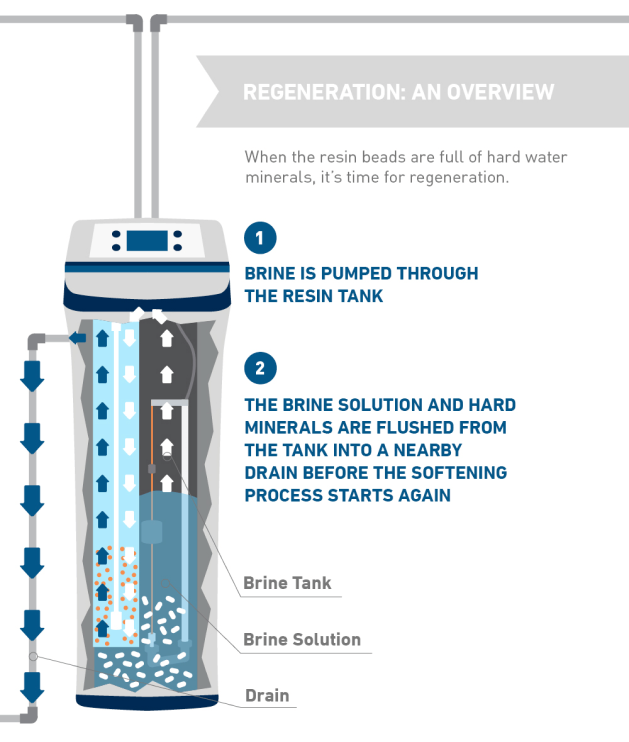How a Water Softener Works
If you have hard water, a water softener is the solution to spotty dishes, dry skin and limescale buildup in pipes and appliances. Here’s how just one system can dramatically improve your water.
If you have hard water, a water softener is the solution to spotty dishes, dry skin and limescale buildup in pipes and appliances. Here’s how just one system can dramatically improve your water.
The Resin Tank is where water enters the softener and flows through resin beads which swap hard water minerals for the tiny sodium ions they’re holding. This ion exchange results in soft water that can then enter the home.
The Resin Bed is a collection of thousands of tiny resin beads inside of the water softener’s tank. When water enters the softener, it flows through the resin bed and comes into contact with the resin beads to generate soft water.


Most newer, high-efficiency water softeners use less than 10 bags of salt per year.
When the resin beads are full of hard water minerals, it’s time for regeneration.
The Brine Tank is where the salty brine solution is generated. The salt mixes with water to create a brine solution that’s flushed through, and cleans the resin beads during regeneration.
Brine Solution is a highly concentrated solution, created from the salt in the tank, that “washes” the resin beads by forcing the minerals out of the resin beads and replaces them with the sodium ions.
The drain is where the brine solution, and the hardness minerals, are flushed away from the softener.


Audio: You’ve noticed the signs of hard water around your home.
Visual: Title: The Hows and Whys of Water Softening – EcoPure
Audio: Spotty dishes, crusty faucets and dull hair and dry skin
Visual: Illustration of spotty dishes, faucet with crust, and sad woman noticing the dull and dry skin on her face.
Audio: Before water enters your home, it has travelled through the earth and collected calcium and magnesium the hardness ions.
Visual: Illustration of a water droplet falling from the sky and down into the earth, where calcium and magnesium ions are present.
Audio: While this water is safe for use once it gets to you, the hardness minerals are still present and they cause big problems around the home.
Visual: Illustration of the water running through pipes and into a bathtub, washing machine and faucet. The water contains hard minerals.
Audio: The solution? A water softener.
Visual: A water softener pops up in the illustration.
Audio: When water enters your home, the first stage of softening begins in the resin tank.
Visual: Pipes connect to the water softener and the inside of the water softener becomes visible, show the resin tank.
Audio: Water circulates in the tank
Visual: A banner with “softening process” text appears.
Audio: where tiny sodium covered resin beads swap the calcium and magnesium in the water for the sodium they’re holding.
Visual: The resin tank is magnified, showing the resin beads swapping the hard ions for the sodium as the water circulates through.
Audio: The beads act as a scrubber removing the hardness minerals out of your water.
Visual: The magnified resin tank shows the hardness minerals being removed.
Audio: This process is referred to as ion exchange and soft water is the result.
Visual: A banner with “ion exchange” text appears.
Audio: When the beads are coated in calcium and magnesium it’s time to regenerate or clean the beads so that they can continue to work their softening magic.
Visual: The magnified area of the resin tank shows hardness minerals back in the water, accumulating in the bottom of the resin tank.
Audio: This is where salt comes in.
Visual: A banner with “Regeneration Process” text appears.
Audio: The salt you add to your softener creates a brine solution that is held in a small reservoir.
Visual: The brine tank in the water softener is magnified, showing the salt mixing with the water.
Audio: The brine is pumped into the resin tank to
remove the hardness minerals from the beads. Once recharged, the beads are ready to soften more water.
Visual: The magnified area moves back to the resin tank, showing the brine removing the hard minerals.
Audio: The used brine and minerals are drained from the softener allowing the cycle to start again and ridding your household of all those pesky hard water problems.
Visual: Hard water flows into the water softener, moving quickly through the softening process to produce soft water.
Audio: With soft water, your water-using appliances will last longer
Visual: The illustration of the woman reappears, and she is happy. A well-functioning washing machine circles her.
Audio: and you’ll spend less time and money on cleaning.
Visual: An illustration of a clock and a dollar sign also begin to circle the woman.
Audio: And it’s all because of one simple system.
Visual: The woman is replaced with an illustration of a water softener at the center of it all.
Audio: If you think you have hard water request your free test kit today and find the best water softener for your home.
Visual: Text appears, “Get a hard water test strip today. www.ecopure.com”.
